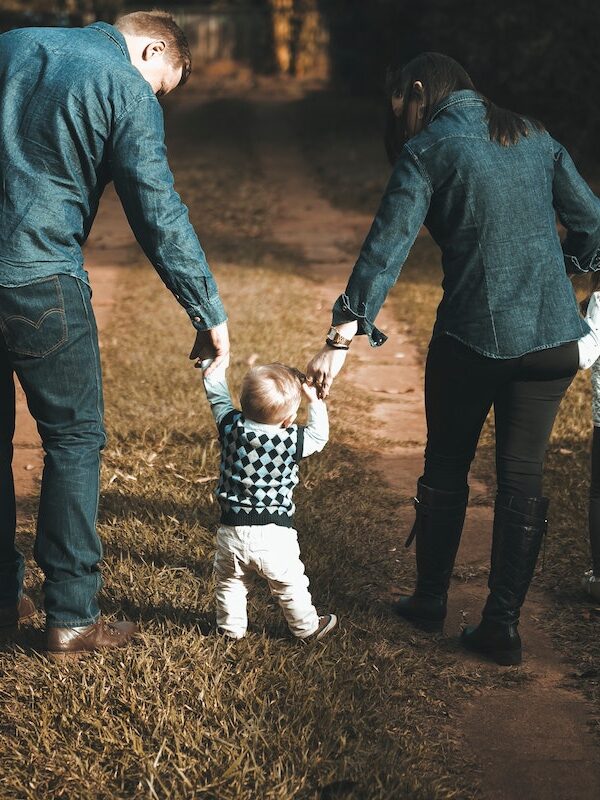Are you looking to turn a simple space into a playroom your kids will love?
Parents, teachers, and aspiring indoor playground owners usually envision playrooms that are both fun and FUNctional. (See what I did there?) The best playroom ideas mix creativity, function, and learning. Have you ever wished your kids had a space that sparked creativity, kept them entertained, and (let’s be honest) helped contain the chaos? I’ll give some tips to help balance design and organization while creating an atmosphere for play. A well-designed playroom can do all that and more! Whether you have a dedicated room or just a small corner, these 20 inspiring playroom ideas will help you create a space your kids will love—and actually use. You may find some ideas you can mix and match. Let’s dive in!
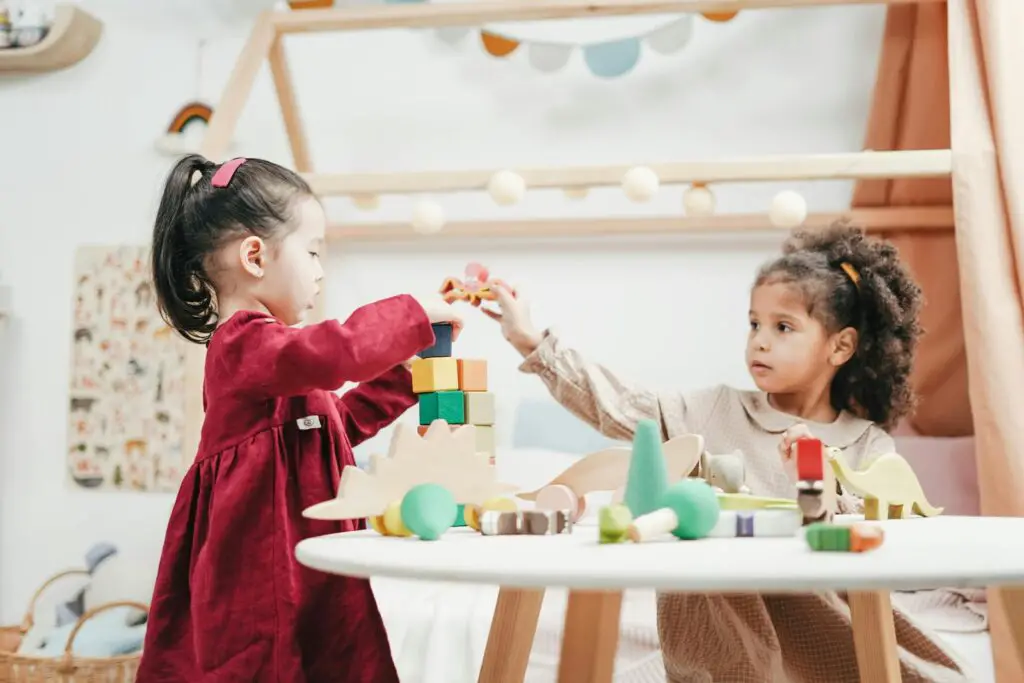
1. Colorful Rainbow Playroom
I’m going to be honest, I personally shy away from painting in bright vibrant colors, especially in homey environments. So when I think about designing a playroom, I’d like to incorporate some sort of down-to-earth element that makes it feel fun and playful but still grounded.
Let’s look at some ways to make those walls pop.
The number one thing I would look for is a paint color that looks good muted and can blend well with different types of shades and textures. Bright walls, playful patterns, and bold furniture can help create an energetic vibe. I’d look for interesting and eye-catching wall decals and consider different ways to create a kid-friendly accent wall.
Whether you go for bright colors, kid-friendly paint, or murals and decals, your children will love the space.
2. Minimalist & Neutral Playroom
Calming tones, simple furniture, and intentional toy storage. For parents who prefer a clean and calming space, a minimalist playroom is the way to go. Choose neutral tones like soft whites, beiges, or greys to create a relaxing atmosphere. Low-profile furniture, open shelving, and neatly arranged baskets keep things visually uncluttered. Use intentional toy storage to ensure every item has a home, making it easier to maintain an organized space. Montessori-style setups often work well in neutral playrooms because they encourage children to play with fewer but more meaningful toys.
3. Montessori-Inspired Playroom
Low shelves, child-friendly furniture, and open-ended toys for independent play. A Montessori playroom is designed to foster independence and creativity. Low, open shelves make toys easily accessible, allowing kids to choose what they want to engage with. Stick to open-ended toys like wooden blocks, dolls, or pretend play sets that encourage problem-solving and imagination. Arrange the room with child-sized furniture, including a small table and chairs for activities. Natural elements like wooden toys and soft rugs add warmth and a sense of calm.
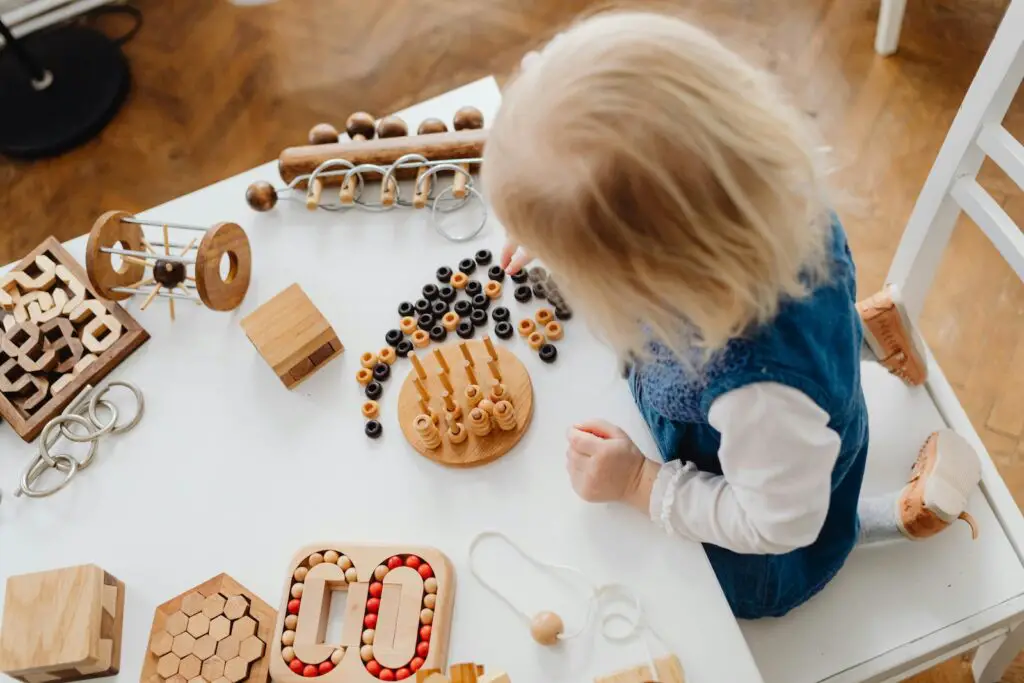
4. Indoor Climbing Wall Playroom
A safe and fun way to encourage movement and adventure. Encouraging movement indoors is a great way to support your child’s physical development. Installing a small climbing wall provides a safe space for kids to build strength, coordination, and confidence. If a full rock wall feels intimidating, start with a climbing arch or a simple ladder leading to a lofted reading nook. Make sure to add padded mats below for safety.
5. Reading Nook Playroom
Cozy corner with bookshelves, comfy cushions, and soft lighting can be a great space for kids to enjoy their favorite books. A reading nook can be the perfect quiet retreat in a playroom. You just need to make sure you choose the right seating! Set up a comfy corner with soft floor cushions, bean bags, and plush rugs. Low bookshelves make it easy for kids to pick out their own stories. To enhance the space, add warm string lights or a canopy to create a cozy ambiance. It’s a playful decorative way to encourage reading early on in one of the most seemingly simple ways.
A good playroom layout includes zones. A cozy reading corner and a small nook with flexible seating are great. Use vibrant colors and versatile decor to make it lively.
6. Adventure & Travel-Themed Playroom
Maps, globes, and explorer-inspired decor. Fuel your child’s curiosity about the world with a travel-themed playroom. Decorate with maps, globes, and posters of famous landmarks. Hang a world map mural or add an interactive pinboard where kids can mark places they’ve learned about. Incorporate adventure-themed play elements like a makeshift airplane cockpit, a treasure chest for pretend pirate quests, or a tent for camping adventures.
7. Pretend Playroom
Play kitchen, market stand, or dress-up station for role-playing fun. Pretend play is an essential part of childhood development. Set up a space with a play kitchen, a market stand, or a dress-up station. Rotating toys can keep things fresh—swap out a grocery store theme for a doctor’s office or a post office. Use labeled bins to keep accessories and costumes organized, making clean-up easy.

8. Arts & Crafts Playroom
Dedicated space with a craft table, supplies, and easy-to-clean surfaces. A dedicated arts and crafts area allows kids to explore their creativity. Set up a child-sized craft table with easy-to-clean surfaces. Use clear jars or labeled bins for organizing supplies like crayons, markers, and paper. A wall-mounted roll of butcher paper is great for large-scale drawings and projects. Displaying their artwork on a gallery wall can also help foster pride in their creativity.
9. Learning & STEM Playroom
Science kits, building blocks, and interactive learning elements. For curious minds, a STEM-inspired playroom provides endless opportunities for hands-on learning. Include a building station with LEGO bricks, magnetic tiles, or wooden blocks. Interactive science kits, a small microscope, or even a DIY experiment station can encourage exploration. A chalkboard or whiteboard wall is perfect for solving puzzles, practicing math, or doodling ideas.
10. Nature-Inspired Playroom
Wooden toys, greenery, and natural materials for a calming space. Bring the outdoors in with a nature-themed playroom. Use wooden toys, natural fiber rugs, and soft greens to create a calming environment. Incorporate real or faux plants to add a touch of nature. A small indoor sandbox or sensory bin filled with natural elements like pebbles and leaves can make for a fun, hands-on play experience.
11. Small Space Playroom Hacks
If you’re looking for ideas for a small playroom, multi-functional furniture is going to be your best friend. A storage ottoman or a bench with hidden spots is great for toys. It keeps the room neat without losing style.
When it comes to small playrooms, use space wisely. Install shelves that reach the ceiling or use wall-mounted storage. This keeps the floor free for play.
Maximizing play areas in small spaces with multi-use furniture. Even if you don’t have an entire room to dedicate, you can still create a functional play area. Use vertical storage to maximize space—think wall-mounted bookshelves, pegboards for hanging toys, or under-bench storage. Foldable furniture and multi-use pieces like a play table with built-in storage help keep things tidy.
12. Indoor Playground Playroom
Here’s a playroom idea kids will love! Add some slides, swings, or mini jungle gyms in your playroom for active play. For high-energy kids, an indoor playground setup keeps them active year-round. There are some options that can be installed safely indoors. Look for compact, removable options if space is limited.
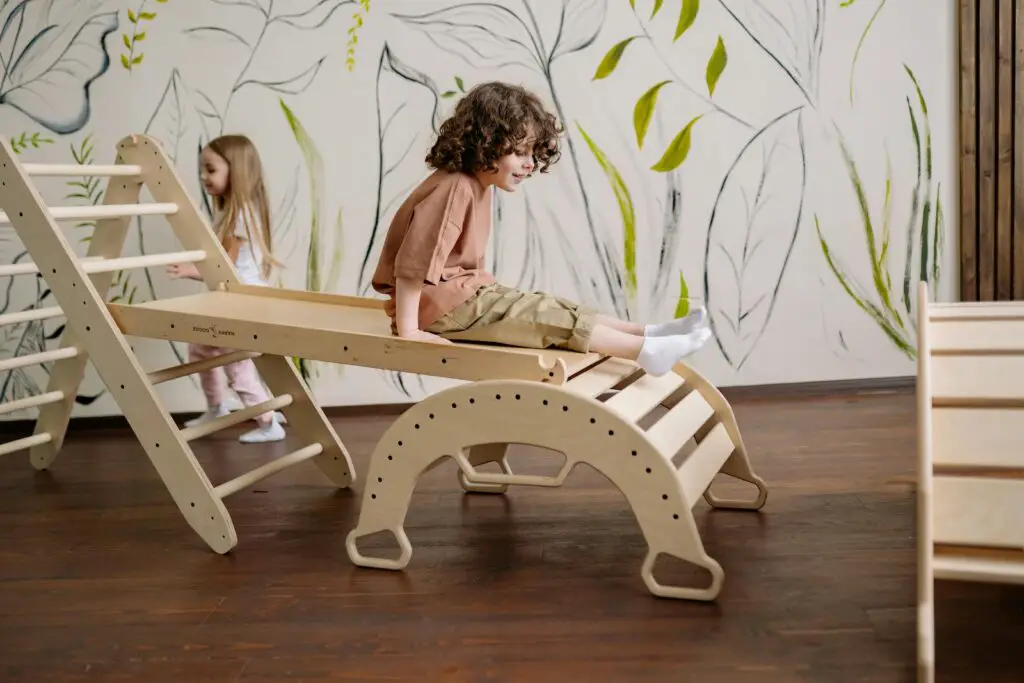
13. Cozy Tent or Fort Corner
A teepee, canopy, or DIY fort for hideouts and quiet time. A tent, teepee, or DIY fort is a magical hideaway for kids. String lights or fairy lights add extra charm, making it a perfect spot for quiet play or naptime.
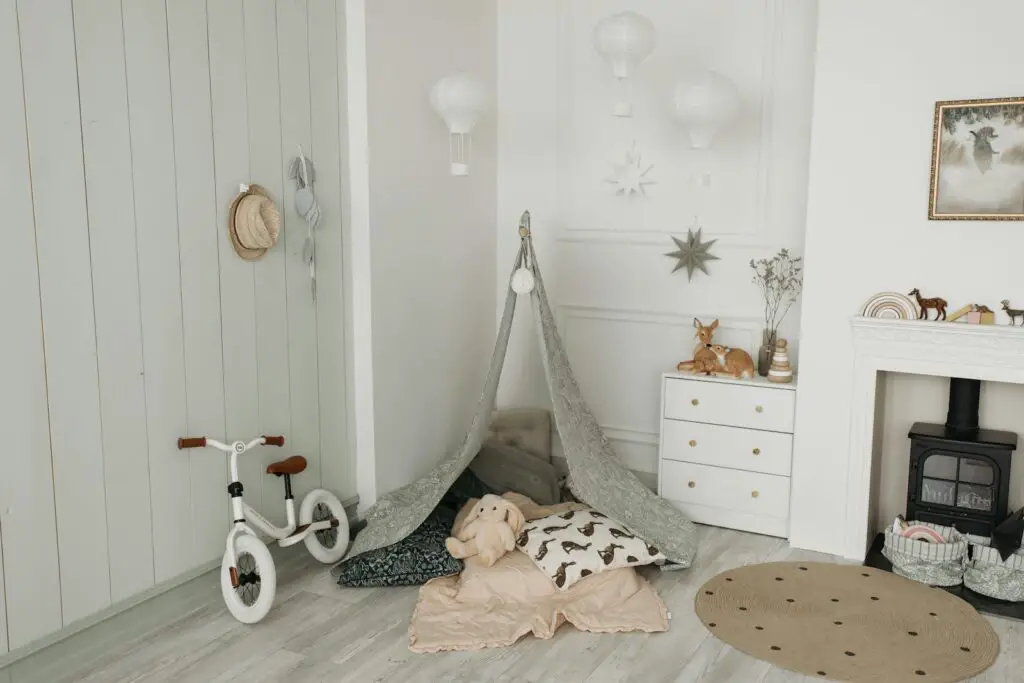
14. Multi-Age Playroom Design
Zones for different age groups to ensure everyone has a space to play. If you have kids of different ages, design zones tailored to their needs. Have a baby-safe area with soft mats, a toddler-friendly toy zone, and a space for older kids to do puzzles, build, or read.
15. Black & White Modern Playroom
Chic, timeless design with high-contrast elements. A chic, high-contrast playroom is both stylish and functional. Use black and white decor with pops of color in toys and accents for a timeless look.
16. Sensory Playroom for Kids
Tactile elements, sensory bins, and textures for hands-on learning. Tactile elements like textured walls, sensory bins, and water play stations help stimulate a child’s senses. This type of playroom is particularly beneficial for children with sensory processing needs.

17. Chalkboard or Whiteboard Wall
Want to make your kid’s play area more fun and creative? I’ve got some playroom DIY ideas to inspire you!
A creative space for drawing, learning, and self-expression. Encouraging self-expression through a dedicated drawing space is a great idea. Paint a wall with chalkboard paint or install a large whiteboard for doodling and learning.
18. Themed Playroom (Space, Jungle, Princess, etc.)
There are so many different themes children will love when it comes to playrooms and you can really go all out. You can go for a space playroom, jungle playroom, princess playroom, ocean playroom, etc. Custom themes that match your kids’ interests will make it that much more special, meaningful, and fun. It’s one of the best ways to personalize the experience for your kiddos. From space adventures to jungle safaris, a themed playroom can make playtime that much more immersive. Let your child’s interests guide the design and go from there.
19. Storage for Playrooms
Finding the right playroom storage can turn chaos into calm. With a few simple solutions, you can make a fun and functional space for your kids. Let’s explore some innovative ideas to keep your playroom organized. Practical solutions like cubbies, labeled bins, and hidden storage. Keep chaos at bay with practical storage solutions. Rotate toys to keep the space fresh.
Bins and baskets are a big help for playroom storage. They’re versatile, come in many sizes, and are easy to move. Storage furniture is great for keeping things tidy. Think about cubby shelves, toy chests, or small wardrobes. These pieces make it easy for kids to put away their toys. Look for furniture that does more than one thing.

20. Convertible Playroom for Growth
A design that evolves with kids, from toddler to pre-teen. Design a space that can evolve with your child. Use adjustable furniture and storage solutions that can transition from toddlerhood to the pre-teen years.
Conclusion
It’s creating a space where your child’s imagination can soar. Bright walls and creative storage are key to a great playroom. DIY projects and educational elements add a lot to a playroom. They make sure the space is both fun and organized. Having areas for reading, art, and play makes the room special. To keep a playroom lively, think about fun equipment and budget-friendly ideas. Interactive boards and multi-functional furniture are great. Remember, the playroom should change as your child grows. Enjoy making it a special part of your home.


